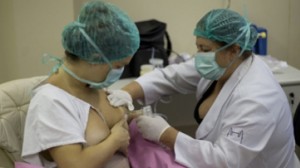
A mother donates milk at the Fernandes Figueira Institute in Rio de Janeiro, Brazil. (AP)
RIO DE JANEIRO (AP) – Thirty years ago, poor Brazilian women were paid for their breast milk, leaving their children at risk of malnourishment. Equipment at the few milk collection centres was so costly it limited the country’s ability to expand the programme’s reach.
That has changed dramatically, thanks in part to Joao Arigio Guerrade Almeida, a chemist who has turned the Brazilian Milk Bank Network into a model studied by other countries and credited with helping slash infant mortality by two thirds.
“Brazil is really the world leader in milk bank development,” said Dr Lisa Hammer, a University of Michigan paediatrician who was part of a team visiting the Rio de Janeiro-based network last week.
Relatively unusual in much of the world, donating breast milk is common in Brazil, where the network of banks works in much the same way as blood banks – testing, sorting and storing milk used mostly to feed premature infants in neo-natal units.
When a mother is unable to breast feed her baby, due to illness, drug addiction or other problems, the network steps in to offer free milk. Last year, it collected milk from some 150 000 women to nourish about 155 000 babies.
Reaching such success was not easy. Almeida recalled the trouble he saw on his first visit to a Rio milk bank in 1985, at the tail end of the country’s two-decade-long military dictatorship.
“What I saw frightened me,” he said. The system relied on “donations” from destitute mothers who often sold so much breast milk they were left without enough for their own infants.
Almeida lobbied for a ban on the sale of breast milk and sought alternatives to expensive imported equipment. High-end pasteurizing machines that cost $25 000 were swapped for $1 500 Brazilian-made machines used in food-testing laboratories.
Jars made for mayonnaise or instant coffee were sterilised to store milk for freezing, replacing imported beaker tubes that had accounted for a whopping 89 per cent of operating costs at Brazilian milk banks.
“We found ways of adapting the system to the reality of a developing country without compromising the quality and safety of the milk,” said Almeida, 57. “We also shifted the focus from the child to the mother, making her into the protagonist.”
Brazilian women increasingly are choosing to nurse, with the Health Ministry estimating more than half of mothers now breast feed exclusively for their children’s first six months of life. In the United States, that rate is 16.4 per cent, according to the Centres for Disease Control, even though breast feeding is widely seen as the best source of nutrition for infants.
Breast milk contains antimicrobial and anti-inflammatory substances that help prevent ailments such as diarrhoea, which can be fatal to infants, and to promote long-term health in ways that dairy-based formulas do not. Premature babies given breast milk often avoid dangerous bowel conditions and other illnesses, allowing them to leave neo-natal units sooner.
Use of breast milk also allows mothers to avoid using potentially contaminated water when they prepare formula for feedings.
Since 1985, Brazil’s infant mortality rate has plummeted from 63.2 per 1 000 births to 19.6 in 2013.
“For a small investment, we’re getting a huge return,” said Almeida. “We get better survival rates and overall health for babies that end up saving the health system money, and we get to reach out not only to mothers of premature babies, but all new mothers and teach them about breastfeeding.”
Public awareness campaigns feature the stars of prime-time soap operas urging new mothers to give milk. Toll-free hotlines and house calls by trained technicians teach would-be donors how to pump their breast milk, sterilise glass jars and keep the milk in home freezers. Home pick-up – by motorcycle messengers in some cities, firefighters, or even police officers in others – made donating easier and more widespread.
The network, with its 214 bank locations, is a rare success story in Brazil’s strained public health system. It has helped set up similar programs in more than 15 Latin American and African nations, as well as in Spain and Portugal. The team visiting from the University of Michigan last week sought tips on setting up a bank at the university’s hospital in Ann Arbor.
In the United States, there are around a dozen banks which generally sell milk for around $4 an ounce, roughly the cost of processing and pasteurising donations.
“Right now in the United States, there’s a lot of emphasis being placed on the promotion of breast feeding. It’s overwhelming that that’s the preferred method of feeding over commercial infant formulas,” Hammer said.
“There’s a lot of government resources, marketing, advertising and money being put into promoting breastfeeding. But taking it to the next step and using donated human milk when mom’s milk isn’t available is not as widely known about or accepted,” she said. “Here in Brazil, there’s just so much awareness.”
